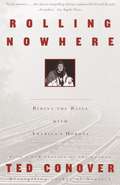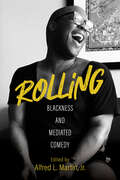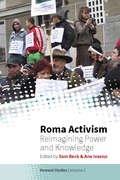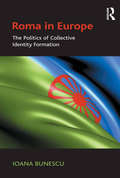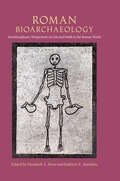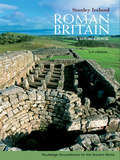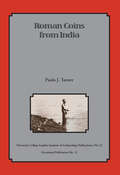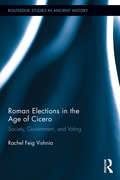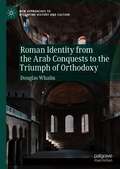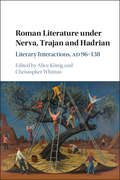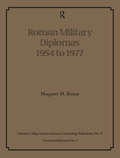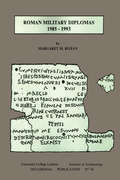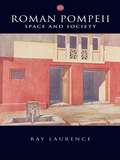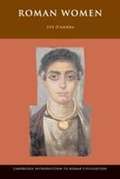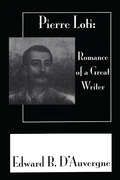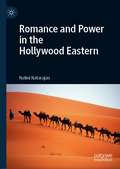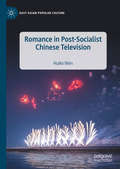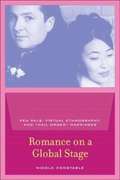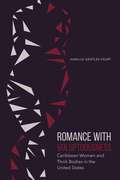- Table View
- List View
Rolling Nowhere: Riding the Rails with America's Hoboes
by Ted ConoverAs a college student, the author decided that he wanted to study the men who have been called hobos, those who travel by hopping freight trains, and who live however they can. He wanted to know whether their lifestyle was as attractive as it seemed to many young people.
Rolling: Blackness and Mediated Comedy (Comedy & Culture)
by Scott Poulson-Bryant Timothy Havens Ken Feil Jacqueline Johnson Gerald R. Butters Jr. Alfred L. Martin Jr. Lisa Guerrero Mel Stanfill Anshare Antoine Ellen Cleghorne Kelly Cole Phillip Lamarr Cunningham Felicia D. Henderson Joshua TrueloveSince slavery, African and African American humor has baffled, intrigued, angered, and entertained the masses.Rolling centers Blackness in comedy, especially on television, and observing that it is often relegated to biopics, slave narratives, and the comedic. But like W. E. B. DuBois's ideas about double consciousness and Racquel Gates's extension of his theories, we know that Blackness resonates for Black viewers in ways often entirely different than for white viewers. Contributors to this volume cover a range of cases representing African American humor across film, television, digital media, and stand-up as Black comic personas try to work within, outside, and around culture, tilling for content. Essays engage with the complex industrial interplay of Blackness, white audiences, and comedy; satire and humor on media platforms; and the production of Blackness within comedy through personal stories and interviews of Black production crew and writers for television comedy.Rolling illuminates the inner workings of Blackness and comedy in media discourse.
Roma Activism: Reimagining Power and Knowledge (Romani Studies #1)
by Sam Beck Ana IvasiucExploring contemporary debates and developments in Roma-related research and forms of activism, this volume argues for taking up reflexivity as practice in these fields, and advocates a necessary renewal of research sites, methods, and epistemologies. The contributors gathered here – whose professional trajectories often lie at the confluence between activism, academia, and policy or development interventions – are exceptionally well placed to reflect on mainstream practices in all these fields, and, from their particular positions, envision a reimagining of these practices.
Roma in Europe: The Politics of Collective Identity Formation
by Ioana BunescuThis path-breaking book explains the processes through which the heterogeneous population of Roma in Europe constitutes itself into a transnational collective identity through the practices and discourses of everyday life, as well as through those of identity politics. It illustrates how the collective identity formation of the Roma in Europe is constituted simultaneously in the local, national, and European contexts, drawing attention to the mismatches and gaps between these levels, as well as the creative opportunities for achieving this political aim. Bunescu demonstrates that the differences and stereotypes between the Roma and the non-Roma, as well as those among different groups of Roma, fulfil a politically creative function for the constitution of a unified transnational collective identity for the Roma in Europe. The book is unique - comprising chapters ranging from local ethnographic accounts of inter-ethnic relations of rural Roma in a Transylvanian village, to interviews with international Roma political activists, controversial Roma kings, and an extensive chapter on their role of bridging the local and the higher levels of identity politics, visual depictions of a diversity of Roma living spaces and interpretations of the politics of space in private dwellings, as well as in public venues, such as at Roma international festivals.
Roman Artisans and the Urban Economy
by Cameron HawkinsThis book offers the first comprehensive study of economic conditions and economic life in Roman cities during the late Republic and early Empire. By employing a sophisticated methodology based upon comparative evidence and contemporary economic theory, the author develops interlocking arguments about the relationship between four key attributes of urban economic life in Roman antiquity: the nature and magnitude of consumer demand; the structure of urban labour markets; the strategies devised by urban artisans in their efforts to navigate their social and economic environments; and the factors that served to limit both the overall performance of the Roman economy, and its potential for intensive growth. While the author's methodology and conclusions will be of particular interest to specialists in economic history, other readers will profit from his discussion of topics such as slavery and manumission, the economic significance of professional associations, and the impact of gender on economic behaviour.
Roman Bioarchaeology: Interdisciplinary Perspectives on Life and Death in the Roman World (Bioarchaeological Interpretations of the Human Past: Local, Regional, and Global Perspectives)
by Elizabeth A. Bews Kathryn E. MarkleinHow bioarchaeology can illuminate the lived experiences of people in the Roman Empire Research on the Roman Empire has long focused on Rome’s legendary leaders, culture, and conquest. But at the empire’s peak, tens of millions of ordinary people coexisted in its territories—people who built the structures, wrote the literature, and transformed the landscapes we study today. In Roman Bioarchaeology, researchers use human skeletal remains recovered from throughout the Roman world to portray how individuals lived and died, spanning the empire’s vast geography and 1,000 years of ancient history. This volume brings together scholarship from archaeological sites in Europe, the Eastern Mediterranean, and Africa, featuring new and advanced scientific approaches including DNA studies, stable isotope analysis, paleoparasitology, paleopathology, biodistance, and more. Throughout, contributors prioritize the ethical treatment of the deceased by highlighting individual narratives and working with local descendants where possible. From rural homes in Britannia to bustling cities in Phoenicia, these essays showcase the diversity of Roman lives and illuminate the experiences of the most vulnerable in these societies. This book demonstrates how bioarchaeology can enrich our understanding of many facets of life in the Roman world. Contributors: Piers Mitchell | Mario Caric | Efthymia Nikita | Gabriele Scorrano | Mahmoud Mardini | Serena Viva | Tracy Prowse | Kathryn E. Marklein | Mario Novak | Olga Rickards | Marissa Ledger | Anna Osterholtz | Pier Francesco Fabbri | Leslie Quade | Sammuel Sammut | Fabio Macciardi | Rebecca Pitt | Elizabeth A. Bews | Mary Lewis | Rebecca Redfern | Rebecca Gowland A volume in the series Bioarchaeological Interpretations of the Human Past: Local, Regional, and Global Perspectives, edited by Clark Spencer Larsen
Roman Britain: A Sourcebook (Routledge Sourcebooks for the Ancient World)
by Stanley IrelandRoman Britain: A Sourcebook has established itself as the only comprehensive collection of source material on the subject. It incorporates literary, numismatic and epigraphic evidence for the history of Britain under Roman rule, as well as translations of major literary sources. This new edition includes not only recently discovered material, but also the texts of Caesar’s commentaries on his expeditions to Britain in 55 and 54 BC, as well as relevant sections of Tacitus’ biography of his father-in-law, former governor of Britain. The inclusion of these pivotal texts, which provide the most detailed account of the Romans campaigns in Britain, significantly underlies the volume’s usefulness to all students of Roman Britain. Though most of the material is arranged chronologically, there are also thematic sections on geography, religion and social and economic activity. Each section is prefaced by an introductory note, and the inclusion of illustrations and maps enhances the attractiveness of this updated collection as a teaching tool and a work of reference.
Roman Coins from India (UCL Institute of Archaeology Publications)
by Paula J TurnerThis book is a detailed collation of the recorded finds of Roman coins on Indian soil, divided into Republican, Julio-Claudian and post-Julio-Claudian coins. It also includes chapters on the historical significance of the scarcity of Roman finds, the absence of base metal issues in the early empire, the predominance of early imperial denarii, and the difference in composition between the Julio-Claudian gold and silver hoards. There is considerable discussion on slashed gold coins and defaced silver coins and on imitation Roman coins found in India. Three exhaustive appendices include a catalogue of finds of Roman coins found in India, the present location of Roman coins found in India, and Roman coins in the Madras Central Government Museum. Copublished with the Royal Numismatic Society.
Roman Dress and the Fabrics of Roman Culture
by Jonathan Edmondson Alison KeithRoman Dress and the Fabrics of Roman Culture investigates the social symbolism and cultural poetics of dress in the ancient Roman world in the period from 200 BCE-400 CE. Editors Jonathan Edmondson and Alison Keith and the contributors to this volume explore the diffusion of Roman dress protocols at Rome and in the Roman imperial context by looking at Rome's North African provinces in particular, a focus that previous studies have overlooked or dealt with only in passing. Another unique aspect of this collection is that it goes beyond the male elite to address a wider spectrum of Roman society. Chapters deal with such topics as masculine attire, strategies for self-expression for Roman women within a dress code prescribed by a patriarchal culture, and the complex dynamics of dress in imperial Roman culture, both literary and artistic. This volume further investigates the literary, legal, and iconographic evidence to provide anthropologically-informed readings of Roman clothing.This collection of original essays employs a range of methodological approaches - historical, literary critical, philological, art historical, sociological and anthropological - to offer a thorough discussion of one of the most central issues in Roman culture.
Roman Elections in the Age of Cicero: Society, Government, and Voting (Routledge Studies in Ancient History)
by Rachel Feig VishniaGreat debate exists amongst classical historians on the nature of Roman republican government. Some contend that the Roman Republic was governed by a small group of aristocratic families that entrenched their rule by means of long-standing alliances and an intricate network of loyal clients from the lower echelons of society. Others contest the definition of the republican government as oligarchic, maintaining that the Roman elite did not operate in a political vacuum and that Polybius’ judgment, which concedes a democratic element in the Roman constitution as embodied in the powers of the popular assemblies, cannot be simply swept aside. This debate has found its way into various scholarly works, but, until now, no single volume has been dedicated specifically to elections and electioneering, a sphere where the people—according to these interpretations—played a central if not a crucial role. Roman Elections in the Age of Cicero provides new and intriguing insights into the nature of Roman republican government and the people’s actual powers, but also addresses questions relevant to elections in our own societies today.
Roman Identity from the Arab Conquests to the Triumph of Orthodoxy (New Approaches to Byzantine History and Culture)
by Douglas WhalinThis book asks how the inhabitants and neighbours of the Eastern Roman Empire understand their identity as Romans in the centuries following the emergence of Islam as a world-religion. Its answers lie in exploring the nature of change and continuity of social structures, self-representation, and boundaries as markers of belonging to the Roman group in the period from circa AD 650 to 850. Early medieval Romanness was integral to the Roman imperial project; its local utility as an identifier was shaped by a given community’s relationship with Constantinople, the capital of the Roman state. This volume argues that there was fundamental continuity of Roman identity from Late Antiquity through these centuries into later periods. Many transformations which are ascribed to the Romans of this era have been subjectively assigned by outsiders, separated by time or space, and are not born out by the sources. This finding dovetails with other recent historical works re-evaluating the early medieval Eastern Roman polity and its ideology.
Roman Legends Brought to Life
by Robert GarlandThe legends of early Rome are among the most memorable of any in the world. They are also highly instructive. They taught generations of Romans about duty and obedience. Duty and obedience might not seem to amount to much these days, but it was precisely these virtues that made Rome great. The legends are not, however, merely self-congratulatory and they are rarely simple exercises in nationalist propaganda. On the contrary, many reveal their ancestors’ dark side, which they expose unflinchingly. As in the case of Greek mythology, there is no authorised version of any Roman legend. The legends survived because they reminded the Romans who they were, what modest beginnings they came from, how on many occasions their city nearly imploded, and what type of men and women shaped their story. Defeat, loss, failure. That’s where this story – the story of the boldest, most enduring, and most successful political experiment in human history – begins. It’s the story of how a band of refugees escaped from the ruins of a burning city and came to establish themselves hundreds of miles to the west in the land of Hesperia, the Western Land, the land where the sun declines, aka Italia. It’s the story of a people who by intermingling, compromise and sheer doggedness came to dominate first their region, then the whole of peninsula Italy, and finally the entire Mediterranean and beyond.
Roman Literature under Nerva, Trajan and Hadrian: Literary Interactions, AD 96–138
by Christopher Whitton Alice KönigThis volume is the first holistic investigation of Roman literature and literary culture under Nerva, Trajan and Hadrian (AD 96–138). With case studies from Frontinus, Juvenal, Martial, Pliny the Younger, Plutarch, Quintilian, Suetonius and Tacitus among others, the eighteen chapters offer not just innovative readings of literary (and some 'less literary') texts, but a collaborative enquiry into the networks and culture in which they are embedded. <P><P>The book brings together established and novel methodologies to explore the connections, conversations and silences between these texts and their authors, both on and off the page. The scholarly dialogues that result not only shed fresh light on the dynamics of literary production and consumption in the 'High Roman Empire', but offer new provocations to students of intertextuality and interdiscursivity across classical literature. How can and should we read textual interactions in their social, literary and cultural contexts?
Roman Military Diplomas 1954 to 1977 (UCL Institute of Archaeology Publications)
by Margaret M RoxanThis volume publishes records 82 diplomas or fragments which provide vital evidence for the Roman military and legal world. It is the first volume of a set of four created by Roxan, the world’s expert on this subject.
Roman Military Diplomas 1985 to 1993 (UCL Institute of Archaeology Publications)
by Margaret M RoxanThis volume publishes records 66 diplomas or fragments which provide vital evidence for the Roman military and legal world. It is the third volume of a set of four created by Roxan.
Roman Phrygia
by Peter ThonemannThe bleak steppe and rolling highlands of inner Anatolia were one of the most remote and underdeveloped parts of the Roman empire. Still today, for most historians of the Roman world, ancient Phrygia largely remains terra incognita. Yet thanks to a startling abundance of Greek and Latin inscriptions on stone, the cultural history of the villages and small towns of Roman Phrygia is known to us in vivid and unexpected detail. Few parts of the Mediterranean world offer so rich a body of evidence for rural society in the Roman Imperial and late antique periods, and for the flourishing of ancient Christianity within this landscape. The eleven essays in this book offer new perspectives on the remarkable culture, lifestyles, art and institutions of the Anatolian uplands in antiquity.
Roman Pompeii: Space and Society
by Ray LaurenceIn this fully revised and updated edition of Roman Pompeii, Dr. Laurence looks at the latest archaeological and literary evidence relating to the city of Pompeii from the viewpoint of architect, geographer and social scientist. Enhancing our general understanding of the Roman world, this new edition includes new chapters that reveal how the young learnt the culture of the city and to investigate the role of property development and real estate in Pompeii’s growth. Showing how Pompeii has undergone considerable urban development, Dr. Laurence emphasizes the relationship between the fabric of the city and the society that produced it. Local activities are located in both time and space and Pompeii’s cultural identity is defined. This book is invaluable for students and scholars in the fields of archaeology and ancient history, as well as being rewarding reading for the many people who visit Pompeii.
Roman Slavery and Roman Material Culture
by Michele GeorgeReplete now with its own scholarly traditions and controversies, Roman slavery as a field of study is no longer limited to the economic sphere, but is recognized as a fundamental social institution with multiple implications for Roman society and culture. The essays in this collection explore how material culture - namely, art, architecture, and inscriptions - can illustrate Roman attitudes towards the institution of slavery and towards slaves themselves in ways that significantly augment conventional textual accounts.Providing the first interdisciplinary approach to the study of Roman slavery, the volume brings together diverse specialists in history, art history, and archaeology. The contributors engage with questions concerning the slave trade, manumission, slave education, containment and movement, and the use of slaves in the Roman army.
Roman Women
by Eve D'AmbraThis richly illustrated book examines the daily lives of Roman women by focusing on the mundane and less-celebrated aspects of daily life -- family and household, work and leisure, worship and social obligations -- of women of different social ranks. <p><p>Using a variety of sources, including literary texts, letters, inscriptions, coins, tableware, furniture, and the fine arts, from the late republic to the high imperial period, Eve D'Ambra shows how these sources serve as objects of social analysis, rather than simply as documents that re-create how life was lived. <p><p>She also demonstrates how texts and material objects take part in shaping realities and what they can tell us about the texture of lives and social attitudes, if not the emotions of women in Roman antiquity.
Roman-Period and Byzantine Nazareth and its Hinterland (The Palestine Exploration Fund Annual)
by Ken DarkRoman-Period and Byzantine Nazareth and its Hinterland presents a new social and economic interpretation of Roman-period and Byzantine Nazareth and its hinterland as a whole, showing the transformation of a Roman-period Jewish village into a major Byzantine Christian pilgrimage centre. Although Nazareth is one of the most famous places in the world, this is the first book on Roman-period and Byzantine Nazareth by a professional archaeologist, the only book to consider the archaeology of Nazareth in the context of its adjacent landscape, and the first to use contemporary archaeological methods and theory to explore Nazareth’s archaeology. Taking as his starting point a systematic survey of the valley between Nazareth and the Roman town of Sepphoris, Dark offers an interpretation of communities elsewhere in the Roman world as networks of interlocking cells, with interactions along routeways being more important in cultural and economic terms than the relationship between urban centres and their surrounding countryside. His conclusions have implications for the wider archaeology of the Roman and Byzantine worlds, as well as for archaeological theory, and demonstrate the importance of Nazareth to world archaeology. This unique book will be invaluable to those interested in Nazareth and its surrounding landscape, as well as to archaeologists and scholars of the Roman and Byzantine worlds.
Romance Of A Great Writer
by D'AUVERGNEFirst published in 2002. Routledge is an imprint of Taylor & Francis, an informa company.
Romance and Power in the Hollywood Eastern
by Nalini NatarajanThis book develops the existence of the "Eastern" as an analytically significant genre of film. Positioned in counterpoint to the Western, the famed cowboy genre of the American frontier, the “Eastern” encompasses films that depict the eastern and southern frontiers of Euro-American expansion. Examining six films in particular—Gunga Din (1939), Lawrence of Arabia (1962), Heat and Dust (1983), A Passage to India (1984), Indochine (1992), and The English Patient (1996)—the author explores the duality of the "Eastern" as both aggressive and seductive, depicting conquest and romance at the same time. In juxtaposing these two elements, the book seeks to reveal the double process by which the “Eastern” both diminishes the "East" and Global South and reinforces ignorance about these regions’ histories and complexity, thereby setting the stage for ever-escalating political aggression.
Romance in Post-Socialist Chinese Television (East Asian Popular Culture)
by Huike WenThis book is about how the representations of romantic love in television reflect the change and the dilemma of the dominant values in post-socialist Chinese mainstream culture. These values mainly center on the impact of individualism, consumerism, capitalism, and neoliberalism, often referred to as western culture, on the perception of romantic love and self-realization in China.The book focuses on how romantic love, which plays a vital role in China’s ideologically highly restricted social environment by empowering people with individual choice, change, and social mobility, must struggle and compromise with the reality, specifically the values and problems emerging in a transitional China. The book also examines how the representation of romantic love celebrates ideals—individual freedom, passion, and gender equality—and promises changes based on individual diligence and talent while simultaneously obstructing the fulfillment of these ideals.
Romance on a Global Stage: Pen Pals, Virtual Ethnography, and Mail Order Marriages
by Nicole ConstableThis book is an ethnographically rich, methodically innovative, theoretically important, and counter-intuitive study of Filipinas, Chinese women, and U.S. men who meet and correspond through the mail or the Internet in hopes of meeting a suitable marriage partner.
Romance with Voluptuousness: Caribbean Women and Thick Bodies in the United States (Expanding Frontiers: Interdisciplinary Approaches to Studies of Women, Gender, and Sexuality)
by Kamille Gentles-PeartOffering a unique vantage point from which to view black women’s body image and Caribbean migration, Romance with Voluptuousness illuminates how first- and second-generation immigrant black Caribbean women engage with a thick body aesthetic while living in the United States. Using personal accounts, Romance with Voluptuousness examines the ways in which black women with heritage in the English-speaking Caribbean participate in, perpetuate, and struggle with the voluptuous beauty standard of the black Caribbean while living in the hegemony of thinness cultivated in the United States. It highlights how black Caribbean women negotiate issues of body image deriving from both Caribbean and American pressures to maintain a particular body shape and contend with discourses and practices surrounding the body that aim to marginalize and exclude them from economic, social, and political spaces. By focusing on diasporic Caribbean women’s “romance” with voluptuousness, Kamille Gentles-Peart explores the transnational flow of beauty ideals and examines how ideas about beauty in the Caribbean diaspora help to shape the experiences of Caribbean black women in the United States.
